
Miao Luo, Director of Technology Strategy at Qt: “Your customer’s convenience is your gain”
There are some interviews you can skim read. Pick out the salient points, move on. As will become clear as you read our full interview with Miao Luo, Director of Technology Strategy at Qt, this isn’t one of those.
Because what will become rapidly obvious is that Miao Luo is one of life’s thinkers. Perhaps it’s due to his training as a software engineer, where solving problems is an exercise of thinking, of applying logic. Perhaps it’s something picked up over a decade of experience leading UI and UX designers – and advanced engineering teams – when building tools that sit at the interface between humans and machines.
We’ll leave you to decide, and in the meantime pass on our thanks to Miao Luo for answering our questions with such depth.
Recommended reading: Marriott taps into personalisation with Adobe Experience Cloud
Could you please introduce yourself to our audience? What motivated you to pursue a career in customer experience, and how did you embark on your journey in this field?
I’m the Director of Technology Strategy at Qt. Historically, I’ve led product managers, UI/UX designers and advanced engineering teams in building products that help enterprise customers design and develop human-machine interfaces.
I was always a fairly technical person, starting off as a computer science graduate, and of course, the very definition of being a professional programmer is to write software based on a customer’s requirements. So, I was already accustomed to listening to feedback, wants and needs, and creating solutions tailored to those issues.
As my career progressed, I kept finding myself in situations where I wanted to do more than fix the engineering problems. I wanted to help the customer and consider the broader context of the problems they face today. That’s how I gradually grew beyond a technical engineer to also become a Sales Engineer and Product Manager – someone who gets to consider every facet of building and selling technology.
Throughout my career, I’ve been fortunate to gradually learn more and more insights about customers from different perspectives. So that includes technical problems customers might face in the early days of a product’s development, but also, asking myself, ‘how is that technical requirement affected by my customer’s workflow and vice versa?’
When I became a product manager, I fell in love with the puzzle of figuring out customers’ expectations. When they land on a solution vendor’s website, what is it they really want? How do they perceive the value proposition and messages? What criteria do they even use to make a decision on what solution to use? It’s been an immensely satisfying process working out what makes customers tick, and since then, it’s been my goal to help them as best I can.
How do you ready yourself for an AI-driven landscape as a customer experience leader? What new skills do you need?
I’d say that the way you ready yourself as a customer experience leader is pretty much the same with or without AI. Fundamentally, what you should be looking at on any day are the pain points and problem spaces that your customers (or your customers’ customers) are facing today. For example, as someone who focuses deeply on emerging technologies in the UI/UX space, there are stark gaps I’m still seeing in the workflows between design and development teams that are slowing down productivity and time-to-market.
One of the most important jobs of any customer experience leader is to keep your ear to the ground. If you’re not spending the time every day to read up on the solutions being built to solve customers’ problems, you will be left behind. The only difference with AI in the mix is that it has vastly accelerated the pace we need to move at to stay up-to-date with innovation. The world sees new applications with built-in AI introduced every single day.
I do think, for example, that AI is going to play a material role in bridging the gap I’ve mentioned between designers and developers for UI/UX development, though you have to pay close attention to not just these innovations but also how you can apply these innovations to solving your customers’ problems.
So, maybe this isn’t a hard skill per se, but if you’re not allocating this time to research, you will get left behind.
Recommended reading: How genius coworker Salesforce Einstein Copilot AI can help your business
What are your thoughts on the escalating integration of AI in customer experience and its potential influence on the future of customer service at large?
I maintain that when it comes to solving customers’ more mundane, repetitive problems, AI will be the natural default for solving ‘boring’ tasks. Where humans will stay most relevant is in understanding the context of the customer’s requirements, but I wager that even this will start to change. You can imagine how customer service chatbots might dramatically improve if they’re interpreting the context of the customer’s problem, rather than being confined to just solving those boring tasks.
This capability is already starting to manifest itself in the software engineering space. If you look at something like code generation, the hardest part isn’t generating the code, but understanding the contextual requirements. Even AI is getting better at helping humans and developers understand these.
For example, I’ve already seen some very deep tech solutions integrating AI with JIRA (a kind of ticketing system and database that collates feature requests and bug reports for engineers to action). Different engineers reading the description of a bug or ‘problem’ will have different interpretations, which can translate into copy errors.
This is a classic case of ‘context matters’, but the interesting thing is that AI can now read a ticket and understand not only the description but also the context. It can even create a recommendation on what the software should be and take action from there. This could have potentially massive implications for productivity and efficiency across industries if applied to customer experience.
Do you anticipate any significant disruptions in customer experience technology for 2024? If so, what are those disruptions and why?
It’s really hard to talk about significant disruptions to customer experience in a vacuum where AI doesn’t exist. If I had to give it weight, I’d say AI will account for about 80% of the disruption, and the remaining 20% won’t be disruptions per se, but disruptions resulting on the back of AI.
A ridiculous amount of investment today is getting wrapped up in large language models (LLMs). Every Big Tech company, not to mention a huge number of startup companies, are developing their own LLM for specialised purposes in vertical markets. It might be tempting to assume that the disruptions from LLMs won’t affect your niche, but the opposite is more likely true. I expect we will only see more and more hyper-specialised LLMs in vertical markets, which will likely translate into a significant paradigm shift for those industries.
So, for example, when it comes to designing better user experiences for customers, you still have to rely on the expertise of designers and developers to create a UI that works on, say, a smartphone app. But in the future, we might see a paradigm shift where a small business can almost entirely rely on AI, where the only human resource that’s truly required is the CEO. They might not even need humans in the loop – whether it be designers, developers, QA or everything else in between. That’s the kind of paradigm shift which I could see unlocking huge amounts of potential for the content creation industry.
That shift will happen in tandem with transforming perceptions of what it means to be a software engineer. People have historically seen software engineering as a kind of privilege that’s exclusive to those who study computer science. In the future, though, it’s more likely that any individual with a great business idea might be able to execute that idea by feeding it into an AI that automates a lot of the processes that previously required human labour.
Recommended reading: The nodding iPad is Apple’s latest smart home brainwave
What core values have played a pivotal role in shaping your approach to customer experience?
My core values – the very same core values that drive Qt – have consistently focused on collaboration, innovation and communication. Obviously, people talk about these all the time from an internal culture standpoint, but to a large extent, people should strive to apply these to any situations where they engage with customers as well.
Even with AI in the mix today, you still have to clearly communicate to customers what practical utility they will get out of the toolboxes they’re adopting. You have to visualise to them how they’re going to achieve their goals in a timely fashion at a reasonable cost. In that sense, you could argue that the core values shaping customer experience today are exactly the same as they were before AI entered the scene. The only difference is that the technology stacks may change dramatically.
What customer experience technology has your company recently embraced and what difference has it made to your business?
One of the things I think will define the next few years is widening access to all the advanced technologies that have previously only been available to a few. You always want to consider the question, ‘how can I meet the customer where they are?’ In other words, how can you make things more convenient for them? Your customer’s convenience is your gain.
We’re big believers at Qt in widening customers’ access to our tools, and with that in mind, we recently brought our human-machine interface development platform to the AWS cloud. What this means is that our customers in the automotive OEM space can take advantage of the design and development tools that are already being used by automotive brands like General Motors, Mercedes Benz and Hyundai.
For us, that’s a whole new business stream. Making our solutions available on the AWS Marketplace and enabling the development of software-defined vehicles via the AWS cloud means we’ve been able to bring the Qt brand and product to millions of new users and developers. They can do most of their software development and testing in the cloud instead of physical hardware, which means no need to wait for expensive board orders to ship and arrive. It saves a lot of time in terms of development and testing, iterating and prototyping.
NEXT UP

James McQuiggan, Security Awareness Advocate at KnowBe4: “Ironically, attack methods have remained unchanged over the past twenty years”
In this interview, we hear from James McQuiggan, Security Awareness Advocate at KnowBe4 and a part-time Faculty Professor at Valencia College in Florida.

What is ocean-bound plastic and should you care?
Lee Grant digs behind the truth about ocean-bound plastics to explain why reducing them is a worthy cause – but that we need to treat marketing claims with due scepticism

Slow buyers cause tech firms to rethink sales approaches as tough Q1 hits home
New research suggests tech sales were slow in Q1, with buyers of technology and professional services taking their time before committing to any solutions.